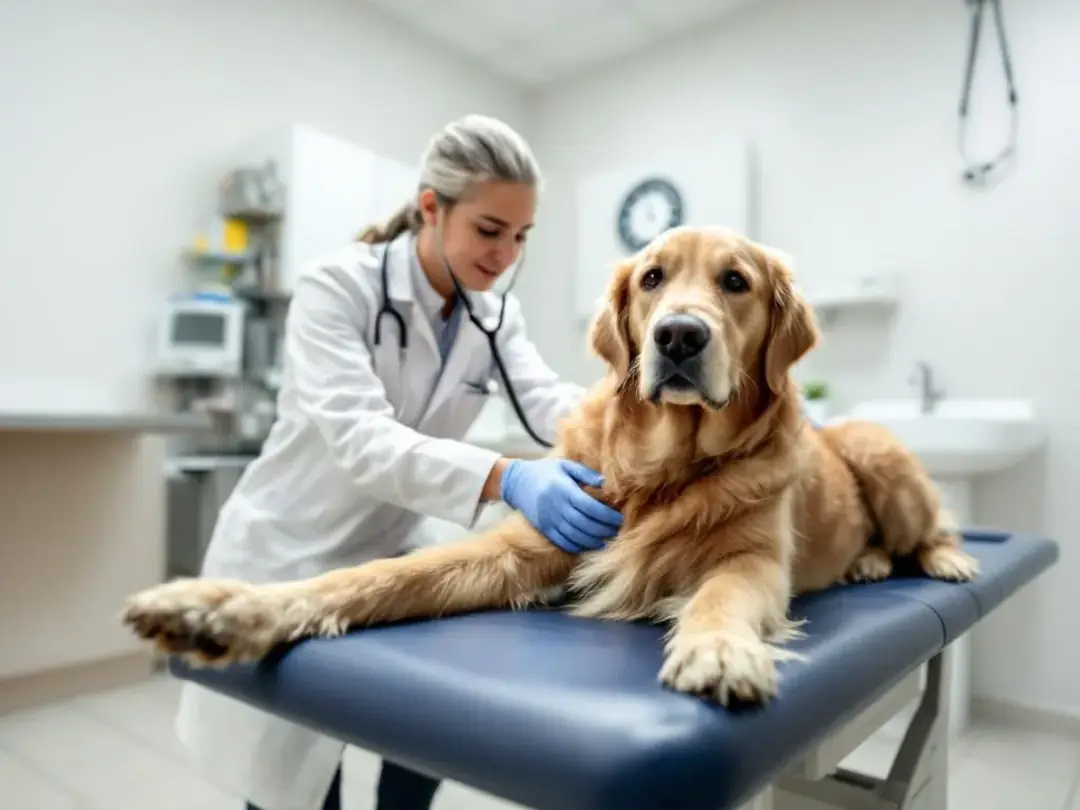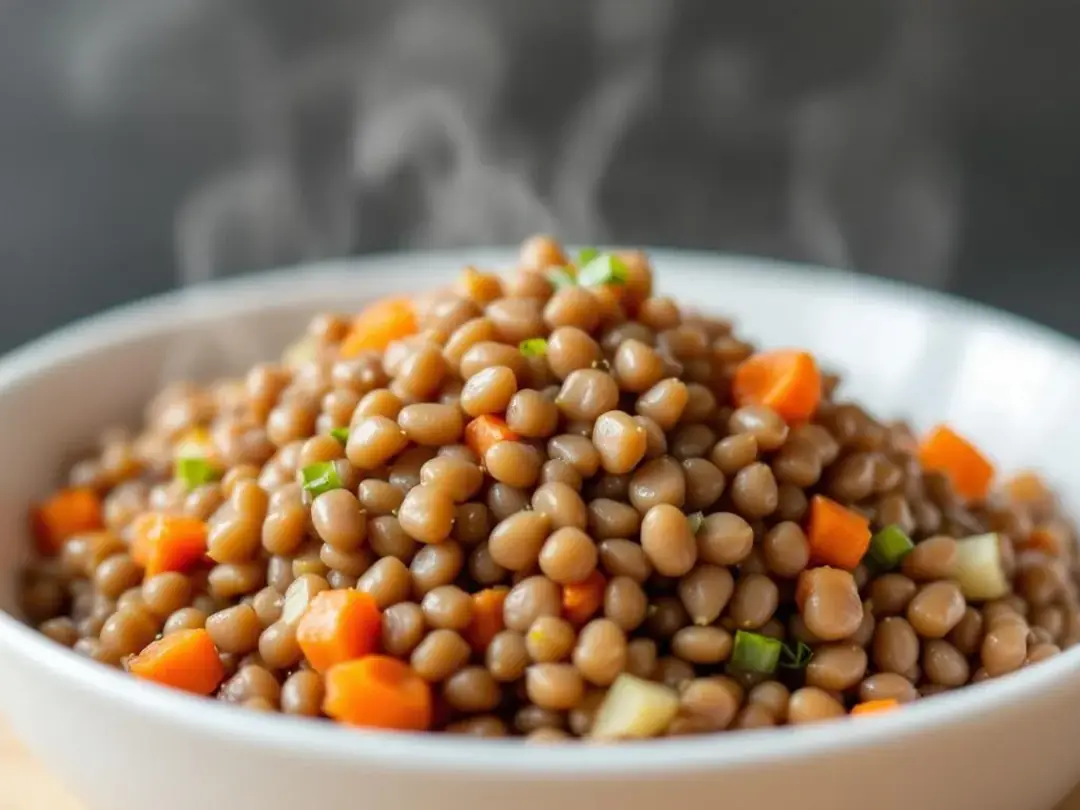Key Takeaways
-
Dogs can safely eat cooked lentils in moderation as they provide excellent protein, fiber, and essential nutrients
-
Raw or dry lentils should never be fed to dogs as they contain harmful lectins and are difficult to digest
-
Proper preparation involves soaking overnight and cooking thoroughly without any spices, salt, or seasonings
-
Feed only 1 teaspoon to 1 tablespoon of cooked lentils a few times per week, depending on your dog's size
-
Always introduce lentils gradually and monitor for digestive upset like gas, bloating, or diarrhea
-
Lentils are a new food for most dogs, so introduce them slowly to watch for any adverse reactions
Are Lentils Safe for Dogs?
Yes, dogs can eat properly cooked lentils in moderation. Lentils are a natural, protein-rich legume that offers significant nutritional benefits when prepared correctly. The safety of eating lentils depends entirely on proper preparation and cooking methods.
Raw lentils pose serious health risks and should never be given to dogs. The compounds present in uncooked lentils can cause severe digestive issues and bacterial growth that leads to serious health complications. However, cooked lentils are commonly used in high-quality commercial dog foods and have been safely consumed by dogs for years.
There is no need to worry about feeding lentils to your dog as long as they are properly cooked and served in moderation.
The key difference lies in the cooking process, which neutralizes harmful compounds and makes the nutrients easily digestible. When you cook lentils thoroughly, they become a valuable source of nutrition that can support your dog's overall health and strong muscles.
Nutritional Benefits of Lentils for Dogs
Lentils pack impressive nutritional benefits that can enhance your dog's diet when incorporated thoughtfully. The high protein content of 18 grams per cup supports muscle development and maintenance, making them particularly valuable for active dogs and growing puppies.
The dietary fiber content of 16 grams per cup promotes healthy digestion and helps maintain firm stools. This fiber also supports beneficial gut bacteria, which plays a crucial role in your dog's immune system and digestive health. For dogs struggling with weight control, the fiber helps create a feeling of fullness without excess calories.
Lentils serve as an excellent source of iron for blood production and energy metabolism. They also contain essential B vitamins including B1, B3, B5, and B6, which support nervous system health and help convert food into energy. The low fat content makes them ideal for dogs needing weight management.
Additional nutritional benefits include zinc and selenium for immune system support, plus antioxidants that help reduce inflammation. For diabetic dogs, lentils help stabilize blood sugar levels due to their low glycemic index, making them a great source of steady energy without glucose spikes.
Types of Lentils Dogs Can Eat
Understanding which lentil varieties work best for dogs helps you make informed choices when selecting this nutritious addition to your dog's meals.
Red Lentils
Red lentils offer a mild taste that appeals to most dogs, including picky eaters. They cook faster than other varieties and become softer, making them easier for dogs to digest and chew. Red lentils are commonly used in premium dog food formulations and pair well with chicken, meat, and vegetables in homemade dog meals.
The softer texture after cooking makes red lentils particularly suitable for senior dogs or those with dental issues. Their quick cooking time also makes them convenient for busy dog owners preparing fresh meals.
Green Lentils
Green lentils provide a larger and firmer texture compared to red lentils while remaining equally nutritious and safe for dogs when cooked properly. They take longer cooking time but maintain their shape better during the cooking process.
These lentils provide the same beneficial nutrients as other lentil varieties and work well mixed with rice or other grains in balanced recipes. Their firmer texture can provide a satisfying chew for dogs who enjoy different textures in their food.
Brown and Black Lentils
Brown and black lentils serve as safe alternatives with similar nutritional profiles to other varieties. They require thorough cooking to ensure proper digestibility but offer the same protein, fiber, and essential nutrients.
While less commonly used in commercial dog foods, these varieties can add variety to homemade meals. The key is ensuring they're cooked until completely soft to prevent digestive issues.


Dangers of Raw and Improperly Prepared Lentils
Raw lentils contain lectins that promote harmful bacterial growth in your dog's digestive system. These naturally occurring compounds can cause severe stomach upset, vomiting, and diarrhea. The presence of these lectins in uncooked lentils makes them potentially toxic to dogs.
Dry lentils present additional hazards beyond their lectin content. They're hard to chew and digest, creating choking hazards, especially for smaller breeds. The hard texture can also damage teeth or cause mouth injuries.
Uncooked lentils can lead to bacterial growth that causes serious digestive tract infections. The lectins interfere with nutrient absorption and can damage the intestinal lining, leading to long-term digestive issues. This is why proper preparation is crucial for your dog's safety.
The compounds in raw lentils can also cause severe inflammation in the digestive system. Watch for signs of distress if your dog accidentally consumes raw lentils, and contact your vet immediately if symptoms develop.
How to Properly Prepare Lentils for Dogs
Proper preparation transforms potentially harmful raw lentils into a safe, nutritious treat for your dog. Start by rinsing lentils thoroughly under cold water to remove dirt and debris that may be present from processing and packaging.
Soak lentils in clean water for 2-8 hours or overnight. This soaking process helps break down compounds that can cause gas and makes the lentils easier to digest. Drain and rinse again before cooking to remove any residual dirt or bacteria.
To cook lentils safely, boil them in fresh water, then reduce heat and simmer for 20-30 minutes until completely soft. The lentils should be tender enough to mash easily with a fork. Never add salt, spices, garlic, onions, or any seasonings during the cooking process, as these can be harmful to dogs.
Allow the cooked lentils to cool completely before serving to your dog. Hot food can burn your dog's mouth and throat. Store leftover cooked lentils in the refrigerator for up to 3 days in an airtight container. Always check for signs of spoilage before feeding leftover lentils.
The cooking process is essential for making lentils safe and digestible. Undercooked lentils can still contain harmful compounds and may be difficult for your dog to digest properly.
Serving Guidelines and Portion Control
Proper portion control ensures your dog receives the nutritional benefits of lentils without digestive upset. Feed 1 teaspoon for small dogs and 1 tablespoon for larger dogs, limiting servings to 2-3 times per week maximum.
Adjust portions based on your dog's size, age, and activity level. Active dogs may benefit from slightly larger portions, while sedentary or senior dogs should receive smaller amounts. Puppies should receive even smaller portions as their digestive systems are still developing.
Introduce lentils gradually, starting with very small amounts mixed with your dog's regular food rather than feeding as a standalone meal. This gradual introduction helps prevent digestive issues and allows you to monitor how many lentils your dog can tolerate.
| Dog Size | Serving Amount | Frequency |
|---|---|---|
| Small (under 25 lbs) | 1 teaspoon | 2-3 times per week |
| Medium (25-60 lbs) | 2 teaspoons | 2-3 times per week |
| Large (over 60 lbs) | 1 tablespoon | 2-3 times per week |
| Lentils should comprise no more than 10% of your dog's total daily calories. They work best as a supplement to a balanced diet rather than a primary food source. Always maintain your dog's regular feeding routine and use lentils as an occasional addition. |
Foods to Avoid When Feeding Lentils
Certain lentil preparations designed for humans can be harmful to dogs and should never be shared. Lentil crisps or chips are a popular snack for humans but are unsafe for dogs due to added seasonings and choking hazards. These products contain harmful seasonings and pose choking risks due to their hard, processed texture.
Canned lentil soups typically contain added salt, garlic, and onions, all of which are toxic to dogs. These ingredients can cause serious health problems including anemia and digestive upset. Pre-seasoned lentil products marketed for human consumption often contain spices and preservatives that aren't safe for dogs.
Avoid lentil dishes cooked with bacon, ham, or other fatty meats, as these add excessive fat and sodium that can cause digestive issues and pancreatitis. Any lentil preparation containing preservatives or artificial additives should also be avoided.
Stick to plain, home-cooked lentils without any seasonings or additions. This ensures your dog receives the nutritional benefits without exposure to potentially harmful ingredients commonly found in human food preparations.


Potential Side Effects and Warning Signs
Common digestive issues from eating lentils include gas, bloating, and stomach discomfort, especially when dogs consume too much or aren't accustomed to high-fiber foods. These symptoms typically resolve within 24 hours if portions are reduced.
Possible diarrhea or constipation can occur from excessive consumption or if your dog has sensitivity to new foods. Monitor your dog's bathroom habits for changes after introducing lentils to their diet.
Signs of intolerance include itchy skin, runny stools, and lethargy. Some dogs may experience vomiting or loss of appetite, indicating digestive distress. These adverse reactions suggest your dog may not tolerate lentils well.
Contact your veterinarian if symptoms persist beyond 24-48 hours or if your dog shows signs of severe discomfort. Individual dogs have varying tolerance levels, and some may simply not be suited for lentil consumption.
Watch for changes in behavior, appetite, or energy levels after feeding lentils. These can indicate whether lentils are agreeing with your dog's digestive system or causing problems that need attention.
Lentils vs Other Dog-Safe Foods
Comparing lentils to other safe foods helps you understand their place in your dog's diet. Lentils provide significantly more protein and fiber than rice, making them more nutritionally dense for dogs needing muscle support.
Rice is more easily digestible but less nutritious than lentils, making it better for dogs with sensitive stomachs but less beneficial for overall nutrition. Lentils offer a superior amino acid profile compared to simple carbohydrates like white rice.
For active dogs requiring sustained energy, lentils serve as a better energy source than rice due to their complex carbohydrate structure and protein content. Both can be part of balanced homemade dog meals when prepared properly.
| Food | Protein (per cup) | Fiber (per cup) | Best For |
|---|---|---|---|
| Cooked Lentils | 18g | 16g | Active dogs, muscle building |
| Cooked Rice | 4g | 1g | Sensitive stomachs, easy digestion |
| Chicken Breast | 43g | 0g | Primary protein source |
| When planning meals, consider lentils as a protein and fiber supplement rather than a replacement for meat. They work well incorporated into recipes with chicken or other animal proteins. |
When to Consult Your Veterinarian
Before introducing lentils to dogs with existing health conditions, consult your vet for personalized guidance. Dogs with diabetes, kidney disease, or digestive disorders may need special consideration when adding new foods to their diet.
If your dog shows any adverse reactions after eating lentils, seek veterinary advice promptly. Your vet can help determine whether the symptoms are related to lentil consumption or indicate other health issues requiring attention.
For guidance on appropriate portions for your specific dog, especially if you're considering making significant dietary changes, professional advice ensures you're meeting your dog's individual nutritional needs safely.
When considering lentils for diabetic or overweight dogs, veterinary input helps you integrate them effectively into a therapeutic diet plan. Your vet can advise on proper portions and timing to maximize benefits.
If digestive symptoms persist beyond 48 hours after feeding lentils, professional evaluation helps rule out other causes and ensures your dog receives appropriate treatment if needed.
FAQ
Can puppies eat lentils?
Puppies can eat small amounts of properly cooked lentils after 12 weeks of age, but consult your vet first as their digestive systems are still developing and they need specific puppy nutrition for proper growth.
Are lentils better than meat for protein?
No, lentils should supplement, not replace, meat protein in a dog's diet. While lentils provide plant-based protein, dogs need complete amino acid profiles found in animal proteins for optimal health and muscle development.
Can dogs with grain allergies eat lentils?
Yes, lentils are legumes, not grains, so they're typically safe for dogs with grain allergies. However, some dogs may have legume sensitivities, so introduce carefully and monitor for reactions.
How long do cooked lentils last for dogs?
Cooked lentils for dogs should be used within 3 days when stored in the refrigerator in airtight containers. Never feed lentils that smell off or show signs of spoilage.
Can I feed my dog canned lentils?
Only plain canned lentils with no added salt, seasonings, or preservatives are acceptable. Always rinse canned lentils thoroughly before serving and check the ingredient list carefully for harmful additives.






